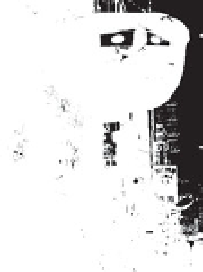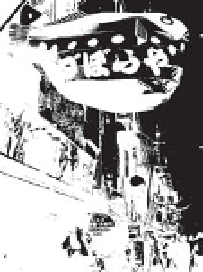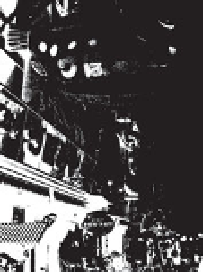Graphics Reference
In-Depth Information
detector. On the average, fewer than three intensity comparisons need to be made
to determine if a candidate pixel is a FAST corner. Both the original detector and the
extended version were found to produce repeatable features while running at least
an order of magnitude faster than the Harris and DoG detectors, enabling frame-rate
corner detection. A later extension that investigated a neighborhood of forty-eight
pixels around the candidate pixel improved the repeatability even more [
402
].
4.1.6.2 Maximally Stable Extremal Regions
Matas et al. [
314
] proposed a new type of feature called
maximally stable extremal
regions
or
MSERs
. These too are extremely fast to compute, and are based on thresh-
olding, a simple image processing operation. An extremal region is defined as a
connected subset of pixels
such that for all
p
∈
and
q
adjacent to but not in
. That is, the pixels
inside the region are either all darker or all lighter than the pixels on the boundary. An
easy way to obtain an extremal region is to threshold the image at a given pixel value;
in this case, each connected component of pixels above the threshold forms a bright
extremal region. As we decrease the threshold, connected components grow in size,
and eventually merge to cover the entire image domain. Conversely, each connected
component of pixels below the threshold forms a dark extremal region, which grows
as the threshold is increased. Figure
4.14
illustrates the concept on a real image.
For detecting features, we choose extremal regions that are stable; that is, as the
image threshold is varied, the connected component changes little. This is desirable
for repeatably finding the same regions in different views of a scene. We can find
these stable extremal regions by finding local minima of the function
, the image intensities all satisfy either
I
(
p
)<
I
(
q
)
or
I
(
p
)>
I
(
q
)
)
=
|
−
|
i
+
1
i
−
1
M
(
i
(4.33)
|
i
|
where
is a nested sequence of corresponding extremal regions obtained by
thresholding the image at intensity
i
, and
{
}
i
|
|
is the area of
i
. Figures
4.15
a and b
i
(a)
(b)
(c)
(d)
Figure 4.14.
Examples of dark extremal regions obtained by thresholding an (a) original image.
(b)-(d) illustrate dark extremal regions (connected components) obtained by highlighting pix-
els below the intensity thresholds 20, 125, and 200, respectively. Bright extremal regions are
obtained by complementing these binary images.






